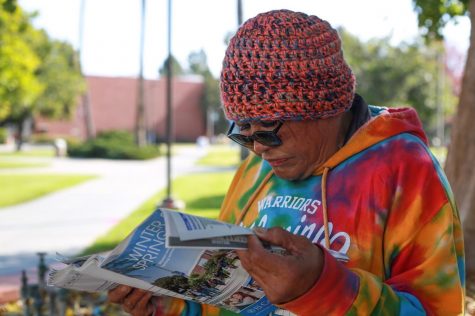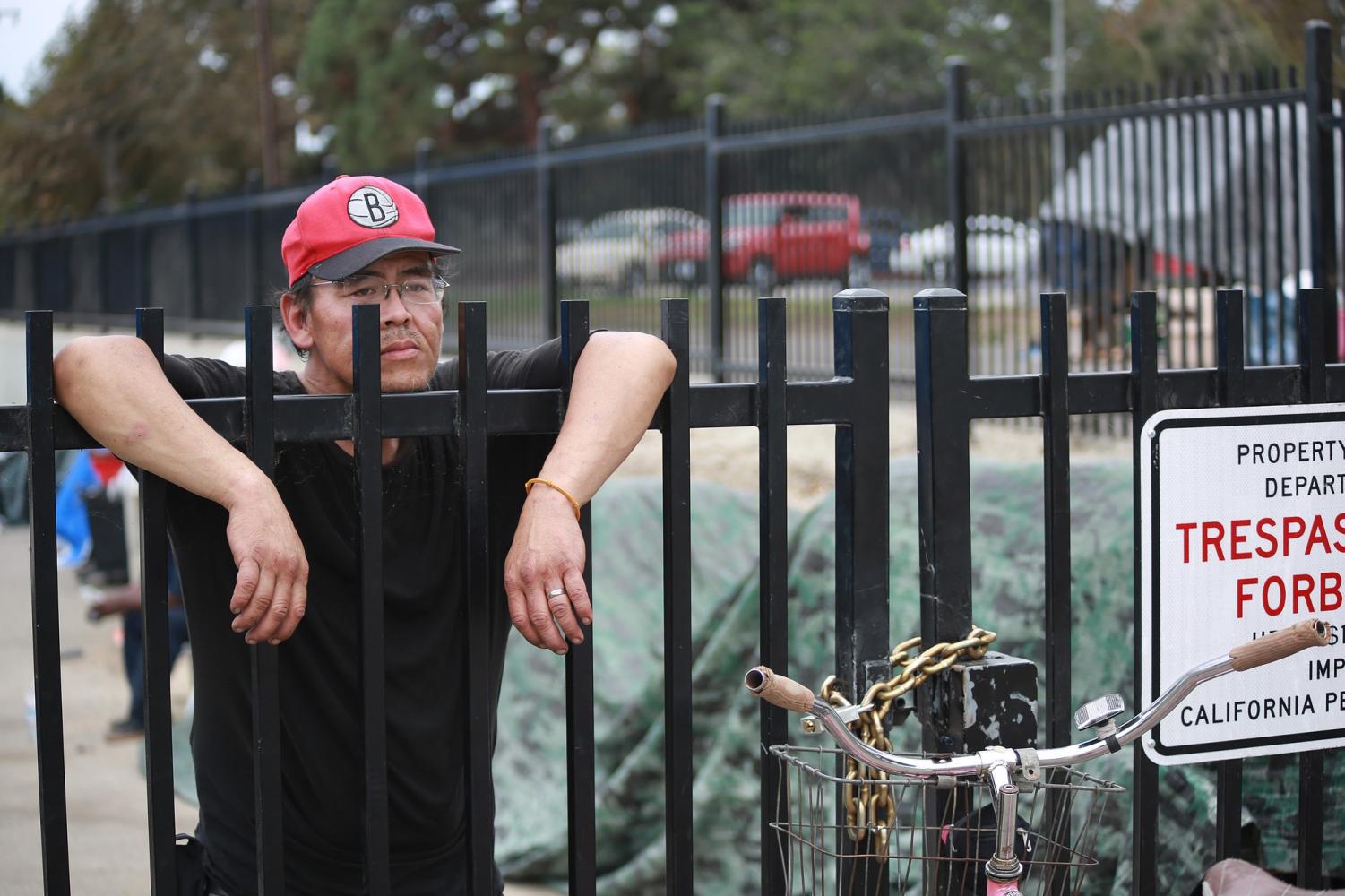Homeless encampment removed from Dominguez Channel; residents displaced
March 27, 2019
Residents of the homeless encampment in the Dominguez Channel next to El Camino College were up as early as 6 a.m. dumping their belongings outside the irrigation system on Tuesday, March 26.
Anything they couldn’t carry themselves was thrown out as part of a scheduled clean-up by the Los Angeles County Department of Public Works.
Residents rushed to eat breakfast and removed their items when a front loader drove up to the channel on Manhattan Beach Boulevard ready to scoop up and throw out any belongings.
“I’m in between being belligerent and being like kind of humiliated because it’s hard for them to understand some shit,” Tony Smith, encampment resident, said. “They should understand that they’re an incident away from being homeless themselves.”
The Los Angeles County Sheriff’s Department worked with the Los Angeles Homeless Services Authority (LAHSA) to clear the channel and provide housing and other services to the residents.
“Prior to today a lot of work has gone into this to treat people with dignity and respect and to try to connect them with a service provider,” Sgt. William Kitchen said. “Whether it is housing, some people simply need IDs, drivers license, Social Security cards to get them connected to services.”
LAHSA also entered the channel and talked with residents of the homeless community but declined to comment about the services they were offering.
Kitchen said that after working with LAHSA in an effort to provide services to those willing to accept them, the county goes through the process of cleaning the channel.
“Everybody knew this was coming,” Kitchen said. “We go down and talk to the people and we try to have the people separate what’s their personal property and what’s trash.”
Kitchen added that the Department of Water and Power provide storage to the residents for 90 days, which they can visit during regular business hours.
However, residents of the encampment were upset at losing what little they called home for the second time in less than a year.
Authorities made sure residents of the channel did not return this time by placing boulders along the ramp that leads into the irrigation system.
Since the cleanup will be a two day process, boulders were placed in the entrance to prevent the resettling of the encampment. #eccunion #homeless #homelessencampment pic.twitter.com/dvxf4z4oTX
— Fernando Haro (@ECCUnionHaro) March 27, 2019
The calm before the storm
Just a couple weeks before the scheduled clean-up, a normal morning began with the stench of a river flowing through the Dominguez Channel filled with dirty mossy water, trash and the occasional propane tank.
When the river floods due to rain, most of the homeless folks prepare by moving their tents up the ramp that leads into the irrigation system to escape the river’s reach.
Laura Martinez had been living in the channel along busy Manhattan Boulevard for eight months when she said she would have never imagined her life turning out like this.

“We had a three bedroom in a suburban area, a Scion, we had everything,” Martinez said. “We went camping, we had a family, and then everything fell apart.”
Now after being kicked out of the Dominguez Channel, Martinez is now displaced again.
She is one of over 50,000 homeless individuals in the greater Los Angeles area, according to the Los Angeles Homeless Services Authority.
Martinez said it has been difficult being homeless and that she has had to develop a thick skin because people view her from a different perspective.
“People tend to think the worst [of homeless people],” Martinez said. “[That] they’re drug addicts, and they’re criminals and they’re stealing.”
Life in the shadows
A typical morning for Martinez consists of a walk to the park to use the restroom and to restock her water supply for the day.
“It’s hard not to have a bathroom, or lights, or water,” Martinez said. “It wears you out lugging water all day and feeling dirty and wondering about what you’re going to eat and where you’re going to cook it.”
However, Martinez said that when they do have enough to eat, it was not convenient to cook in the channel.
“You can’t really cook big meals because it’s only one burner but I’ve tried,” Martinez said. “I cooked the rice first because it stays warmer longer, then the meat and leave the rest for later.”

Each resident of the encampment had a role within the community. Some cleaned, some cooked and some found it upon themselves to keep everything in order.
“But there’s people who think that [we] are thinking of ways to ruin the community,” Martinez said. “That’s not at all what it’s like. [But] one bad apple can ruin the rest of the bunch.”
A harsh reality
“When you don’t really have anything down here, you can’t really find work, it’s almost impossible,” Martinez said. “On top of that, you create bad habits that are detrimental to you finding a job.”
Martinez said that although there are shelters available, they are often far away, leaving her feeling out of place with only a few items she can carry.
But Martinez said homeless individuals require help far beyond just housing.
“The help that you need is not just physical but mental and medical,” Martinez said. “To send somebody to a shelter doesn’t do nothing. It’s like saying ‘shoo, get out of here and don’t come back.’”
Martinez said that the lack of help is why shelters are overflowing with people with mental health issues and criminals.
Martinez added she felt safest in the channel where there was a developed sense of family among residents of the encampment.
Attempting to rebuild
After living in the homeless encampment along the Dominguez Channel for a long while, Roxann Toshiko Tomiyasu, 65, decided it was time to back to school when her daughter graduated from EC in 2015. Living out of her broken-down Ford Explorer parked next to EC on Manhattan Beach Boulevard, Tomiyasu studies automotive technology and is trying to become an automotive technician.

“I have to keep on moving on so my daughter can feel proud of me,” Tomiyasu said. “She wants me to get a job instead of getting all this hard time and struggling.”
Tomiyasu has lived on the streets since the 1980s and became addicted to alcohol and heroin. She found it difficult to take control of her urges, she said.
In order to keep herself in line, she got pregnant.
“I had to get pregnant even though I wasn’t married just to keep me off of heroin and alcohol—just to keep me responsible,” Tomiyasu said.
Knowing she had a baby made her straighten out and become someone different for someone else. She remembers telling her daughter that she could put her up for adoption but her daughter refused; she wanted to stay with her mother.
Her daughter lived with her for a period of time and eventually went on to attend and graduate from EC. If her daughter could do it, Tomiyasu said she could do it as well.
Over the past three years, she has become more relaxed and less-stressed throughout the day, Tomiyasu said. Other individuals in homeless situations should also try to attend school so they can work towards something for themselves, she added.

“I think it’ll help them a lot mentally instead of being stagnated and being dumbfounded,” Tomiyasu said.
Residential community response
Despite the hardships faced by encampment residents, there have been mixed responses by the surrounding community regarding the situation along with claims that residents of the homeless encampment are involved with drug use or trading, attempted car break-ins and stealing mail.
“There is definitely a risk of higher crime, burglary, and break-ins with the homeless community across the street,” Carla Waffer, daughter of an El Camino Village resident, said.
Waffer said she recalls a situation where she had to call the police when she discovered an individual had been stashing their belongings under a tree in her mother’s lawn.
Waffer added that a police officer came over to throw the items out into the street and, although the individual was never identified, the items disappeared.
However, EC Chief of Police Michael Trevis said it is important to help everyone in the community while being compassionate.
“The challenge is to try to encourage and get that person to want that help,” Trevis said. “Unfortunately, there is an element of homeless people that for whatever reason they just do not want to help themselves.”
Trevis said that while homeless shelters are available, some individuals may be discouraged to stay there because there are too many rules they’ll have to follow.
Trevis also added that EC offers an equal opportunity to everybody and anybody can enroll in classes.
“If somebody is homeless and they wanted to enroll in classes, they can,” Trevis said. “They can apply for fee waivers, just like anybody else. We also have the Warrior Pantry.”

